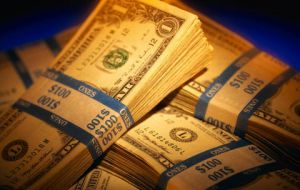MercoPress. South Atlantic News Agency
Weak dollars help surprise drop in April US trade deficit

The United States trade deficit fell unexpectedly in April to 58.5 billion US dollars, helped by the weak dollar which makes US exports more competitive and depresses demand for imports.
The April figure is 6.2% below March's 62.4 billion US dollars and average market expectations of an increase to 63.5 billion in April. Actually US exports rose by 0.2% to a record 129.5 billion said the US Commerce Department, led by aircraft sales, while imports fell by 1.9% to 188 billion. However despite the narrowing of the overall deficit, the US trade gap with China jumped 12.3% to 19.4 billion, the highest level since January. Analysts say this will undoubtedly cause displeasure on Capitol Hill, since many US congressmen argue that China is using unfair practices to boost its exports. Many in the US maintain that since the Chinese government does not allow the Yuan to trade freely, the country's exports are artificially cheap. But looking ahead US market analysts pointed out that even when the narrowing of the overall deficit was "a positive sign", two key issues remain: possible higher US interest rates and energy prices. The Federal Reserve next meets to consider US interest rates on 27-28 June. While most analysts expect rates to remain at 5.25% this time, where they have been for the past year, there is now some concern that the Fed may raise rates further towards the end of the year to control inflation. This would have an even greater impact on the troublesome US housing sector. Last week's minutes from the Federal Reserve's rate-setting meeting said that inflation was still the "predominant concern" for the economy. This week the European Central Bank hiked the main interest rate 25 basic points to 4% and said it "remained accommodative" to prices growth.




Top Comments
Disclaimer & comment rulesCommenting for this story is now closed.
If you have a Facebook account, become a fan and comment on our Facebook Page!